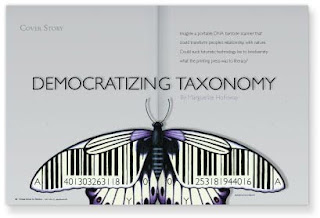 ScentScape system adds an olfactory dimension to gaming and home videos Retailers, hotels and real estate agents have been using aromas to entice us to part with our cash for years now and there have even been a few attempts to transmit smells via the internet and mobile phones. California-based company Scent Sciences is now looking to bring an olfactory dimension to computer games with its ScentScape personal digital scent delivery system.
ScentScape system adds an olfactory dimension to gaming and home videos Retailers, hotels and real estate agents have been using aromas to entice us to part with our cash for years now and there have even been a few attempts to transmit smells via the internet and mobile phones. California-based company Scent Sciences is now looking to bring an olfactory dimension to computer games with its ScentScape personal digital scent delivery system. Scent Sciences’ President and CEO, Bill Wiles, told Gizmag the ScentScape system uses a combination of hardware, software & algorithms and chemistry – all covered by patents – to produce the smells. The system consists of a unit that plugs into a PC or gaming console via USB and generates smells using scent cartridges. Similarly, the ScentScape system and ScentScape Editor can be used to add smells to home videos. Specific themed cartridges such as holiday, summer, ocean, etc. will also be available for this purpose, along with special cartridges for aromatherapy and other applications.or, you could jut go for a walk in the woods!
Scent Sciences’ President and CEO, Bill Wiles, told Gizmag the ScentScape system uses a combination of hardware, software & algorithms and chemistry – all covered by patents – to produce the smells. The system consists of a unit that plugs into a PC or gaming console via USB and generates smells using scent cartridges. Similarly, the ScentScape system and ScentScape Editor can be used to add smells to home videos. Specific themed cartridges such as holiday, summer, ocean, etc. will also be available for this purpose, along with special cartridges for aromatherapy and other applications.or, you could jut go for a walk in the woods!ScentScape® is an innovative digital scent delivery system which provides the extra dimension of scent to gaming, entertainment and other consumer markets. Scent Sciences' technologies enriches the user experience by layering scents to enhance immersion and presence with unique delivery hardware, software and services. Simply connect the Plug-N-Play unit to any compatible PC or gaming console for an instant experience of sight, sound and smell.
ScentEditor® "Scent Enable Your Home Videos" Enhance the viewing experience of your home movies by adding the scents you experienced during the filming such as birthday cake, flowers, fresh mowed grass, ocean, or roasting turkey. The ScentEditor® along with the ScentScape® digital scent delivery system is an easy to use application which provides the tools to add scent during the editing process. Imagine smelling the Christmas Tree when viewing your family's Christmas morning videos several years from now!
Coming soon: Scent enabling applications for gaming, YouTube, Facebook and other popular applications.
I know, let's get Mikey, he'll try anything! Hey Mikey, he likes it! he likes it! Mikey, wake up, Mikey?



